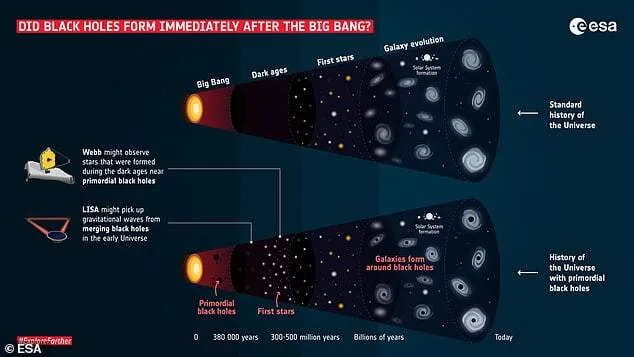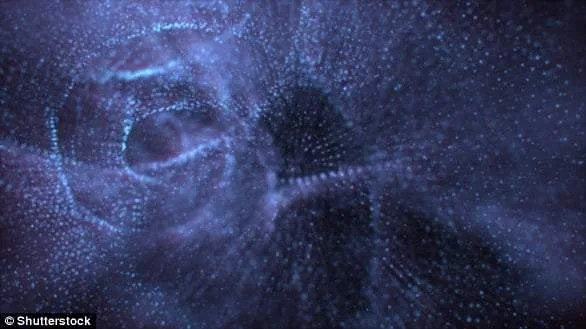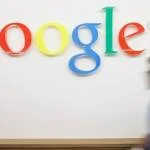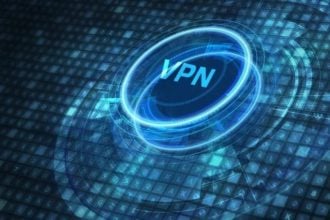Stephen Hawking was RIGHT!
In 1974, Stephen Hawking and his doctoral student Bernard Carr proposed that primordial black holes, hypothetical black holes that existed just after the Big Bang, could be the elusive dark matter first theorised in 1933 – and 47 years later, that theory could be proven.
- Stephen Hawking proposed primordial black holes existed soon after the Big Bang and could be the elusive dark matter first theorized in 1933
- A new study shows this theory could be true, with a few modifications to Hawking’s proposal
- The study suggests the first stars and galaxies of the universe would have formed around black holes
- This allowed black holes to grow into supermassive black holes by feasting on gas and stars in their vicinity
- Scientist also say that black holes have been prove, which could account for all the dark matter that has yet to be found
Astrophysics at Yale, the University of Miami and the European Space Agency (ESA) have adjusted the famous psychist’s proposal and created a new model of how the early universe might have formed.
The new model shows that the first stars and galaxies may have formed around black holes, which had the ability to transform into supermassive black holes, feeding on gas and stars in their vicinity or merging with other black holes.
“If most primordial black holes were ‘born’ about 1.4 times the mass of the Sun, they could potentially make up all dark matter,” said Yale theorist, professor of astronomy and physics Priyamvada Natarajan.
“The primordial black holes, if they really exist, could very well be the seeds from which all supermassive black holes are formed, including the hole in the center of the Milky Way,” she continued.
In 1974, Stephen Hawking and his doctoral student Bernard Carr proposed primordial black holes, which are hypothetical black holes, which existed just after the Big Bang and could be the elusive dark matter first theorized in 1933 – and 47 years later. their theory could be proven
Many experts suggest that about 85 percent of all matter in the universe is dark matter, but for such a large amount it has never been seen or detected. Black holes, on the other hand, have been observed and we even have an image of one to prove their existence.
Hawking and Carr argued that in the first moments of the Big Bang 13.8 billion years ago, “lumpy” regions could have formed in the universe that had extra mass and turned into black holes as they collapsed.
Their theory, however, did not catch on in the scientific community, but a new study shows that with a few modifications, Hawking may have been right.

The new model shows that the first stars and galaxies would form around black holes that would have the ability to turn into supermassive black holes by feasting on gas and stars in their vicinity or merging with other black holes.
“What I personally find very exciting about this idea is how elegantly combines two really difficult problems that I’m working on – studying the nature of dark matter and the formation and growth of black holes – and solves them in one fell swoop. Natarajan said.
Unraveling the mystery of primeval black holes would also solve another cosmic conundrum that has baffled scientists: the vast amount of radiation that has been detected from distant and dark sources scattered throughout the universe.
Natarajan and his colleagues said that growing primordial black holes would have “exactly” the same radiation signature.

The existence of primeval black holes could finally be determined by the James Webb Space Telescope, due to launch on December 22nd, and ESA’s Laser Interferometer Space Antenna (LISA) mission announced for the 2030s
The existence of primeval black holes was finally determined by the James Webb Space Telescope, which is due to launch on December 22nd, and the ESA’s Laser Interferometer Space Antenna (LISA) mission announced for the 2030s.
The mission of the James Webb telescope will be to find the first galaxies to form in the early universe and to see the stars that make up planetary systems.
Meanwhile, LISA will be able to receive gravitational wave signals from early primordial black hole connections.
“If the first stars and galaxies already formed in the so-called ‘dark ages’, Webb should be able to see their evidence,” says astronomer Günther Hasinger of the European Space Agency.
James Webb should reveal new and unexpected discoveries and help humanity understand the origin of the universe and our place in it.
One goal is to go back over 13.5 billion years to see the first stars and galaxies that formed several hundred million years after the Big Bang.
The telescope will primarily observe the universe in the infrared, while Hubble‘ has examined it since its launch in 1990 primarily at optical and ultraviolet wavelengths.
Webb has a much larger light-gathering area, which allows it to look at greater distances and therefore further back in time than Hubble.
Dark matter: The mysterious substance that makes up 85% of the universe that scientists cannot confirm
Dark matter is a hypothetical substance that makes up about 85 percent of the universe.
The enigmatic material is invisible because it does not reflect light and has never been directly observed by scientists.
Astronomers know it exists because of its gravitational effects on known matter.
The European Space Agency says: ‘Light a torch in a completely dark room and you will only see what the torch lights up.

Dark matter is a hypothetical substance that would make up about 27% of the universe. It is believed to be the gravitational “glue” that holds galaxies together (artist’s impression)
“That doesn’t mean the room around you doesn’t exist.
“Likewise, we know dark matter exists but have never observed it directly.”
The material is believed to be the gravitational “glue” that holds galaxies together.
Calculations show that many galaxies would be torn apart instead of spinning if they were not held back by a large amount of dark matter.
The observable universe consists of only five percent of known matter, such as atoms and subatomic particles.







